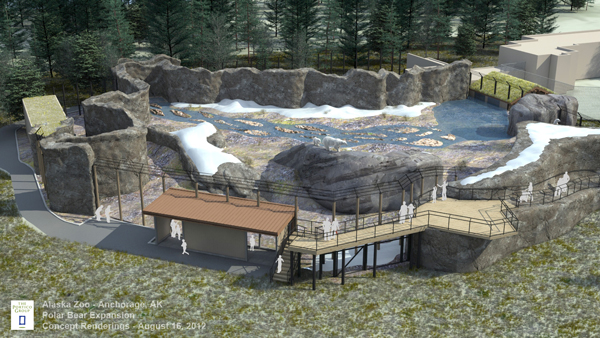
Polar Bears in the US were listed as threatened in May of 2008. In past years, the Alaska Zoo has provided a temporary home for nine orphaned polar bear cubs, in cooperation with the US Fish and Wildlife Service. It isn’t easy to raise a polar bear cub. Alaska Zoo director Pat Lampi ought to know.
“We’ ve had two within the last less than four years. So we feel it is important to be ready.”
Lampi says the Zoo needs more room for cubs.
“You can’t introduce a young cub with an adult for two to three years. And so we don’t have the facility, currently, to keep any more adults.”
Right now, The Zoo’s permanent polar bear exhibit has room enough for two adult residents. Ahpun came to the zoo as an orphan from the North Slope, Lyutik was born in captivity in Russia, then sent to an Australian zoo before ending up in Alaska.
It is hoped that the two bears will become more than roommates, and plans are to expand the polar bear enclosure to provide denning space for Ahpun, should she become pregnant
“If our female got pregnant, you’d need have to have some separation from her and the male. If we have to separate our bears for some reason, currently they’re either.. one can be inside and one can be outside. So this would give us the opportunity if we have to sep Ahpun and Looie, that we could move one of them over to this new area. They would have a separate denning area and some outdoor area and some small pools to acces. “
The Alaska Zoo’s ambitious expansion plan will be completed in two phases. Phase 1 will be a transition facility for orphan bear cubs, and Phase 2 will triple the size of the current permanent polar bear exhibit, including maternity dens.
Last year, the Fish and Wildlife Service gave the Zoo a five year authorization to stand by as a rescue facility for North Slope polar bears. The Alaska Zoo is the only facility in the US to have such an agreement with the federal agency.
And with all eyes on a defrosting Arctic and the area’s new potential for development, there is bound to be more human – bear encounters. Lampi says polar bears are being forced into areas where there are more humans, and that means there will be more orphan cubs looking for a home. )
“Alaska is the only state that has polar bears native to its lands. If there should be a premiere exhibit on this species, it should be in Alaska. “
Eileen Floyd is the Zoo’s major gifts director. Floyd says the expansion plan has been under consideration for five years. The cost of the combined phases is about 8 million dollars, but the Zoo has most of the 1 point 4 million (dollars) needed to begin work on the orphan cub transition facility. Fundraising has begun on the 6 million (dollars) for Phase Two.
Lampi and Floyd say many zoos are not taking polar bear cubs now, because of recent rules set by the government of Manitoba
“Those standards are being adopted by zoos in the United States. That’s the new bar for everybody to reach. ” ” So if you are building a polar bear exhibit, you’re going to build to those standards. “
The Zoo’s expansion will be up to the Manitoba standards, with natural substrate in the the outdoor yard area where bears can dig to their heart’s content. Polar bears can live up to 40 years in captivity, and can breed well into their twenties. Breeding polar bears in captivity could help researchers understand the reasons for reproductive failures in declining wild populations
“It’s for the benefit of the wild population, and the captive population,” Lampi says.
The cub Kalli will someday provide wild population DNA for future breeding programs. Lampi says a polar bear raised in captivity would most likely spend it’s life in captivity. He says the future of the polar bear can’t be predicted during this time of change. But science can help:
“Keep and eye on the science, and what’s going on with the pack sea ice up there. They’re an amazing species, and it would be devastating to let them die off. “
The Alaska Zoo collaborates with the Cincinnati and Memphis Zoos on reproductive studies on polar bears. Other studies could show how much energy it costs a polar bear to swim, and one would even set protocols on how to wash polar bears in the event of an Arctic oil spill. Specially designed washing tables are already in place at Prudhoe Bay and at the Alaska Zoo.
APTI Reporter-Producer Ellen Lockyer started her radio career in the late 1980s, after a stint at bush Alaska weekly newspapers, the Copper Valley Views and the Cordova Times. When the Exxon Valdez ran aground in Prince William Sound, Valdez Public Radio station KCHU needed a reporter, and Ellen picked up the microphone.
Since then, she has literally traveled the length of the state, from Attu to Eagle and from Barrow to Juneau, covering Alaska stories on the ground for the AK show, Alaska News Nightly, the Alaska Morning News and for Anchorage public radio station, KSKA
elockyer (at) alaskapublic (dot) org | 907.550.8446 | About Ellen




